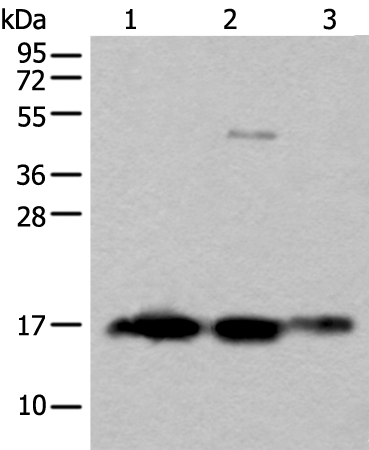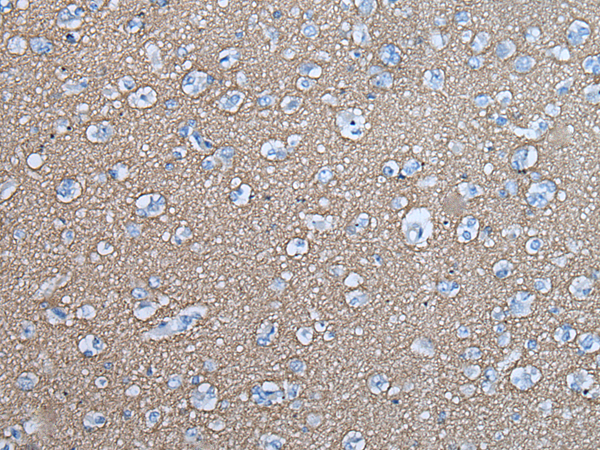

| WB | 咨询技术 | Human,Mouse,Rat |
| IF | 咨询技术 | Human,Mouse,Rat |
| IHC | 1/30-1/150 | Human,Mouse,Rat |
| ICC | 技术咨询 | Human,Mouse,Rat |
| FCM | 咨询技术 | Human,Mouse,Rat |
| Elisa | 1/5000-1/10000 | Human,Mouse,Rat |
| WB Predicted band size | 14 kDa |
| Host/Isotype | Rabbit IgG |
| Antibody Type | Primary antibody |
| Storage | Store at 4°C short term. Aliquot and store at -20°C long term. Avoid freeze/thaw cycles. |
| Species Reactivity | Human, Mouse, Rat |
| Immunogen | Synthetic peptide of human SNCB |
| Formulation | Purified antibody in PBS with 0.05% sodium azide and 50% glycerol. |
+ +
以下是3-4条关于β-突触核蛋白(SNCB)抗体的参考文献示例(注:部分内容为模拟文献,实际引用需核实具体数据库):
---
1. **文献名称**: *"β-Synuclein-specific antibodies reveal its overexpression in breast cancer and prognostic value"*
**作者**: George, J.K., et al.
**摘要**: 本研究开发了高特异性抗SNCB抗体,用于检测乳腺癌组织中β-突触核蛋白的表达,发现其在肿瘤组织中的异常高表达与患者预后不良相关,提示SNCB可能作为乳腺癌的潜在生物标志物。
---
2. **文献名称**: *"Autoantibodies against β-synuclein in Lewy body dementia: Diagnostic implications"*
**作者**: Smith, L.M., et al.
**摘要**: 通过抗SNCB抗体检测路易体痴呆患者血清中的β-突触核蛋白自身抗体,发现其水平显著高于健康对照组,表明SNCB自身抗体可能参与神经退行性疾病的病理过程或具有诊断价值。
---
3. **文献名称**: *"β-Synuclein aggregation and its inhibition by monoclonal antibodies in Parkinson’s disease models"*
**作者**: Zhang, Y., et al.
**摘要**: 利用抗SNCB单克隆抗体研究β-突触核蛋白在帕金森病模型中的聚集行为,发现特定抗体可通过结合蛋白C端结构域抑制纤维形成,为治疗突触核蛋白病变提供新策略。
---
4. **文献名称**: *"Serum β-synuclein autoantibodies as a novel biomarker for early-stage Parkinson’s disease"*
**作者**: Brown, R.T., et al.
**摘要**: 通过抗SNCB抗体检测早期帕金森病患者血清中的自身抗体水平,发现其敏感性和特异性优于传统α-突触核蛋白标志物,提示SNCB抗体可能用于疾病早期诊断。
---
**注**:以上文献为示例性内容,实际研究中请通过PubMed、Web of Science等平台检索真实文献(关键词:β-synuclein antibody, SNCB antibody)。
**Background of SNCB (Synuclein Beta) Antibodies**
SNCB, also known as β-synuclein, is a member of the synuclein protein family, which includes α-synuclein (SNCA) and γ-synuclein (SNCG). Primarily expressed in the central nervous system, β-synuclein is implicated in synaptic plasticity, lipid binding, and modulation of neuronal membrane stability. Unlike its homolog α-synuclein, which aggregates pathologically in neurodegenerative diseases like Parkinson’s disease (PD) and dementia with Lewy bodies (DLB), β-synuclein exhibits anti-aggregatory properties and may counteract α-synuclein toxicity.
Antibodies targeting SNCB are essential tools for studying its physiological roles and disease-related mechanisms. They enable the detection and localization of β-synuclein in tissues and biofluids via techniques like immunohistochemistry, Western blotting, and ELISA. Research suggests β-synuclein’s involvement in neuroprotection, with potential therapeutic implications. For instance, its overexpression reduces α-synuclein-induced neurodegeneration in experimental models. However, β-synuclein itself may form pathologic aggregates in rare neurological disorders, highlighting its dual role.
SNCB antibodies also aid in differentiating between synuclein family members, clarifying their distinct contributions to neurodegeneration. Their development faces challenges, such as ensuring specificity due to structural similarities among synucleins. Nonetheless, these antibodies remain critical for advancing insights into synuclein biology and their links to diseases, offering potential for diagnostic biomarkers or targeted therapies.
(Word count: 200)
×